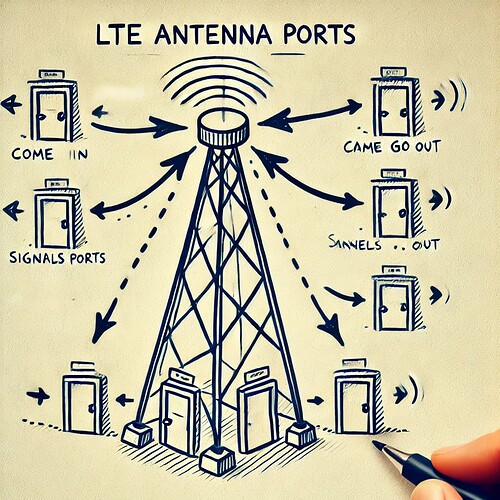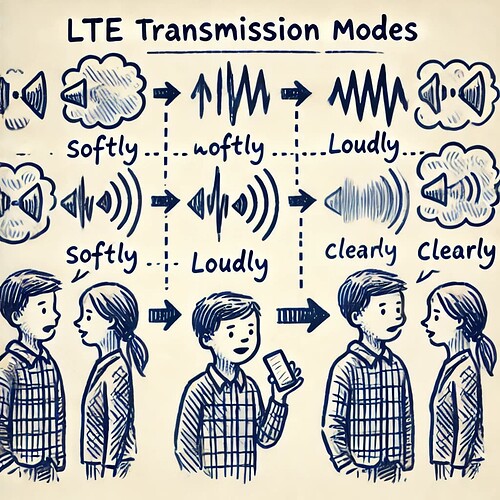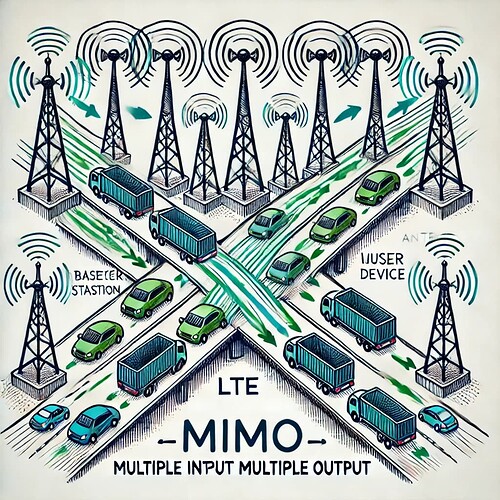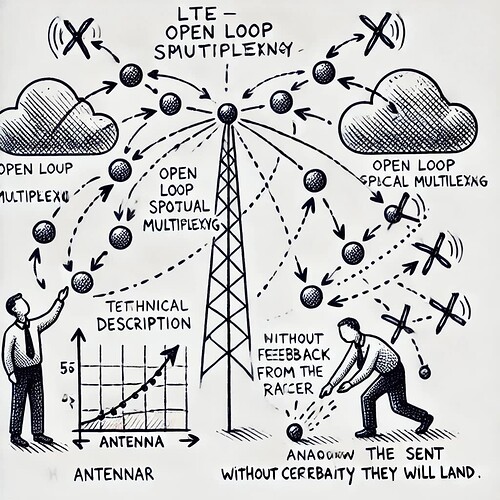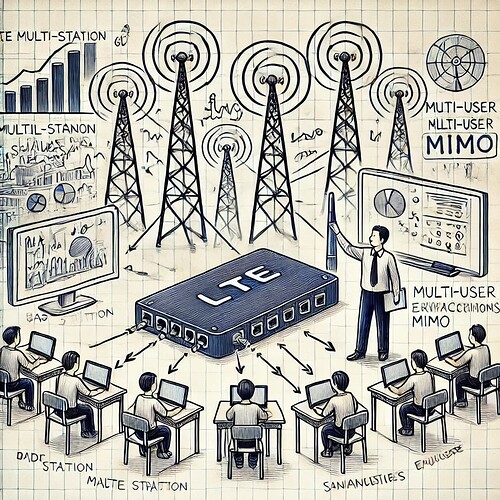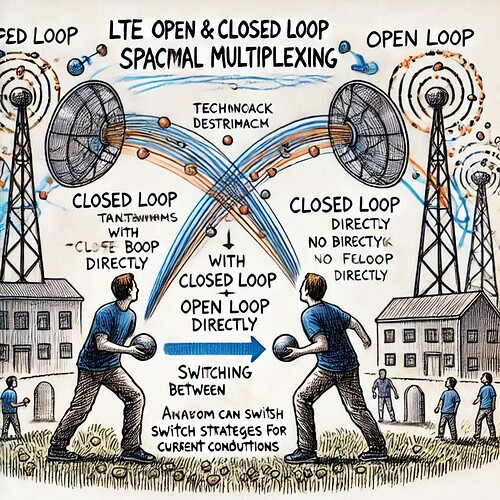This topic presents in a very simplified way all the main concepts that should be understood by those who know LTE.
LTE Downlink Multiple Antenna Technologies
Downlink Multiple Antenna Technologies refer to techniques used to improve data transmission in wireless communication systems, specifically for the communication between a base station and user devices.
Including Open and Closed Loop Spatial Multiplexing, Beamforming, and Multi-User MIMO, it use advanced antenna setups and transmission methods to improve the speed, capacity, and reliability of wireless networks.
![]() Advanced methods to send signals from antennas to different devices - how we can use antennas and smart techniques to make communication faster and clearer, even when many people are using the network at the same time.
Advanced methods to send signals from antennas to different devices - how we can use antennas and smart techniques to make communication faster and clearer, even when many people are using the network at the same time.
Skip to: Roadmap to LTE
- Antenna Ports
- Transmission Modes
- Multiple Input Multiple Output (MIMO)
- Open Loop Spatial Multiplexing
- Closed Loop Spatial Multiplexing
- Beamforming
- Multi-User MIMO
- Open and Closed Loop Spatial Multiplexing
Antenna Ports
These are logical points through which data is transmitted in a multi-antenna system. Each port can be associated with one or more physical antennas.
![]() Antenna Ports are like points on an antenna where data comes in or goes out. Think of them as doors through which signals can travel.
Antenna Ports are like points on an antenna where data comes in or goes out. Think of them as doors through which signals can travel.
- Search Forum
 LTE Antenna Ports
LTE Antenna Ports 
Transmission Modes
Different methods used to send signals to devices. These modes can adjust based on network conditions to either increase data speed or improve signal reliability.
![]() Transmission Modes are the different ways the signals are sent. Just like you can talk loudly or softly depending on who you’re talking to, these modes change based on how strong or clear the signal needs to be.
Transmission Modes are the different ways the signals are sent. Just like you can talk loudly or softly depending on who you’re talking to, these modes change based on how strong or clear the signal needs to be.
- Search Forum
 LTE Transmission Modes
LTE Transmission Modes 
Multiple Input Multiple Output (MIMO)
A system where multiple antennas are used both at the transmitter (base station) and receiver (user device). This improves the capacity of wireless communication by sending and receiving multiple data streams at the same time.
![]() Multiple Input Multiple Output (MIMO) is when we use more than one antenna at the same time (like a multi-lane highway). This helps send and receive more information all at once, making things faster.
Multiple Input Multiple Output (MIMO) is when we use more than one antenna at the same time (like a multi-lane highway). This helps send and receive more information all at once, making things faster.
- Search Forum
 LTE Multiple Input Multiple Output (MIMO)
LTE Multiple Input Multiple Output (MIMO) 
Open Loop Spatial Multiplexing
A technique where multiple data streams are transmitted without feedback from the receiver. This can increase data rates but may not be as efficient when channel conditions vary.
![]() Open Loop Spatial Multiplexing is a way to send several data streams at the same time without knowing exactly how the signals will reach the other end. It’s a bit like throwing several balls in different directions without knowing exactly where they will land.
Open Loop Spatial Multiplexing is a way to send several data streams at the same time without knowing exactly how the signals will reach the other end. It’s a bit like throwing several balls in different directions without knowing exactly where they will land.
- Search Forum
 LTE Open Loop Spatial Multiplexing
LTE Open Loop Spatial Multiplexing 
Closed Loop Spatial Multiplexing
Similar to Open Loop, but with feedback from the receiver, which helps optimize the transmission by adjusting how signals are sent based on current channel conditions.
![]() Closed Loop Spatial Multiplexing does the same thing as Open Loop but with feedback. This means the receiver (like your phone) tells the transmitter (like the tower) how to throw the balls better, so they land in the right spot.
Closed Loop Spatial Multiplexing does the same thing as Open Loop but with feedback. This means the receiver (like your phone) tells the transmitter (like the tower) how to throw the balls better, so they land in the right spot.
- Search Forum
 LTE Closed Loop Spatial Multiplexing
LTE Closed Loop Spatial Multiplexing 
Beamforming
A method that directs the signal towards specific users using multiple antennas. This enhances the signal strength and reduces interference to improve the quality of communication.
![]() Beamforming is like shining a flashlight. The antennas focus the signal in one direction, making it stronger and clearer for the person at the other end.
Beamforming is like shining a flashlight. The antennas focus the signal in one direction, making it stronger and clearer for the person at the other end.
- Search Forum
 LTE Beamforming
LTE Beamforming 
Multi-User MIMO
A variation of MIMO where the base station can send data to multiple users at the same time, increasing the overall network efficiency.
![]() Multi-User MIMO allows the antenna system to talk to many devices at once, like a teacher giving instructions to several students in the classroom, making everything more efficient.
Multi-User MIMO allows the antenna system to talk to many devices at once, like a teacher giving instructions to several students in the classroom, making everything more efficient.
- Search Forum
 LTE Multi-User MIMO
LTE Multi-User MIMO 
Open and Closed Loop Spatial Multiplexing
A combination of both methods, allowing the system to switch between them based on current conditions, to ensure smooth and efficient data transmission.
![]() Open and Closed Loop Spatial Multiplexing combine the strategies of sending signals with or without feedback. This means the system can switch between them to keep communication smooth.
Open and Closed Loop Spatial Multiplexing combine the strategies of sending signals with or without feedback. This means the system can switch between them to keep communication smooth.
- Search Forum
 LTE Open and Closed Loop Spatial Multiplexing
LTE Open and Closed Loop Spatial Multiplexing 
That’s it. ![]()
-
Continue reading: Roadmap to LTE - Downlink Signals
-
Or back to: Roadmap to LTE
